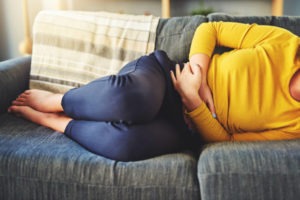
Do you suffer from heavy and painful periods? Are there days you can’t get out of bed the pain is just so bad? You may have endometriosis.
Endometriosis is a condition where tissue similar to the endometrium (lining of the uterus) grows outside the uterus. This tissue usually proliferates in and around the pelvic region and can be attached to the ovaries, fallopian tubes, bowel and bladder and rarely at other sites such as the lungs. If endometrial tissue invades the uterine wall, it is called adenomyosis. Typically, endometriosis is associated with excess oestrogen as it stimulates the growth of ectopic endometrial tissue.
The distressing pain and infertility associated with endometriosis has been documented for over 4,000 years. In fact, history chronicles many failed bizarre and terrifying treatments which led physicians to conclude that sufferers were actually hysterical, promiscuous, possessed or mentally ill! It wasn’t until the Austrian pathologist Karl von Rokitansky first identified microscopic ‘fibrous tumours’ that resembled endometrial glands in the 1860s that a physical cause was connected to the pain and infertility of endometriosis. Today, 1 to 10% of all women, and up to 50% of infertile women, have endometriosis (1).
So what are the symptoms of endometriosis?
Common symptoms of endometriosis include chronic pelvic pain, increased period pain and heavy bleeding, pain on intercourse and impaired fertility. It also commonly presents with digestive symptoms such as bloating, abdominal pain and constipation/diarrhoea. The association between endometriosis and digestive issues is so strong that some researchers have suggested that all females who have IBS (Irritable Bowel Syndrome), should be screened for endometriosis. Studies have also shown that females with endometriosis are more likely to experience gut conditions such as IBS, Inflammatory Bowel Disease and coeliac disease (2). Beyond the physical symptoms, the pain and infertility of endometriosis is also linked to clinical depression.
What causes endometriosis?
Whilst the exact aetiology is unknown, accumulating evidence suggests that endometriosis is caused by a combination of epigenetic, hormonal, inflammatory and immunological (including autoimmune) factors. The various theories include:
- Retrograde menstruation: this theory suggests that endometriosis occurs due to the retrograde (or backward) flow of sloughed endometrial cells/debris via the fallopian tubes into the pelvic cavity during menstruation. However, retrograde menstruation is not unique to endometriosis- it is a defining aspect of endometriosis as an immune disorder.
- Metaplasia: this theory proposes that endometriosis originates from the abnormal differentiation of specialised extrauterine cells (metaplasia) found in the mesothelial lining of the visceral and abdominal peritoneum into endometrial cells.
- Hormone: the growth of lesions is thought to be stimulated by excess oestrogen. Endometriosis is also primarily a disease of women in reproductive age and not usually seen in postmenopausal women.
- Environmental toxins: studies indicate that formaldehyde exposure in foetal development, mould and dioxin (xeno-oestrogen) increase the incidence of endometriosis due to their ability to mimic the body’s natural oestrogen via interaction with receptors.
- Immune dysregulation: while endometriosis is not classified as an autoimmune disease, research suggests that there is an increased risk of autoimmune disease in women with endometriosis. Sufferers have increased macrophage, prostaglandin, lymphocyte and cytokine action and decreased cellular immunity and natural killer cells further indicating the involvement of the immune system.
- Dysbiosis: Research has shown that females with endometriosis are more likely to have an imbalanced microbiome and have increased amounts of pathogenic, or “bad” bacteria like E. coli.An overabundance of bad bacteria can lead to leaky gut which can allow the passage of contents from the gut such as food and bacterial toxins into the pelvic region. In fact, endometriosis sufferers are found to have high levels of a gut-derived bacterial toxin known as lipopolysaccharide (LPS) in the pelvic region. LPS can exacerbate endometriosis by stimulating the growth of endometrial lesions and leading to more inflammation.
What are the main risk factors for developing endometriosis?
The main risk factors include:
- Inheriting the condition from your mother
- Women with shorter menstrual cycles and longer duration of blood flow
- Lack of exercise from an early age
- A high-fat diet
- Use of intrauterine devices
- Hormonal imbalance
- Obesity, and associated insulin resistance may contribute to the inflammatory load
- Excessive use of tampons
Diagnosis and Conventional Treatment
Endometriosis remains a mysterious disease of many ailments, with delayed diagnosis as patients tend to be asymptomatic in the early stages and worsening menstrual pain is frequently normalised. True diagnosis currently requires invasive laparoscopic surgery which is usually reserved to investigate infertility and severe pelvic pain, causing diagnostic delays by 8 to 10 years. By this time, the disease is usually deeply established. Treatment focuses on drug therapy to assist with pain relief and hormone suppression. Surgical interventions include periodic removal of endometrial lesions through laparoscopy, severing of the spinal nerve pathways responsible for pain and partial or complete hysterectomy.
While these options can give some relief, they do present some disadvantages. Long term use of pharmaceutical pain medications such as NSAIDs influence multiple systems such as cardiac, immune, gastrointestinal, renal, vascular and pulmonary systems. Hormonal treatments are often accompanied by unwanted effects, delated conception and recurrence of disease when ceased. Laparoscopic surgery does not remove the lesions from forming and often multiple surgeries are required. There is a 10-15% recurrence rate within 12 months. Even removal of the ovaries and/or uterus does not necessarily stop the condition.

A Naturopathic Approach to Treatment
As every woman experiences the condition differently, it’s important that treatment is individualised. It is however important to reduce inflammation, improve immune function and modulate hormone levels. Some dietary and lifestyle guidelines that assist in the management of endometriosis include:
- Eliminate all known food allergens including dairy, wheat, citrus, corn, soy and fish. A gluten free diet has been shown to improve symptoms in 75% of patients. Gluten stimulates the release of inflammatory cytokines, increasing inflammation in the body.
- Minimise diary intake- A1 casein from dairy is also associated with an inflammatory response as it stimulates histamine and inflammatory cytokine release. A1 casein is found only in the milk of Holstein (Friesian) cows, which are the main herds in Australia, the UK, the US and Canada.
- Watch out for dietary amines- dietary amines have been implicated in Endometriosis due to their additive effect on histamine load implicated by oestrogen’s impacts of histamine degradation. Patients who present with migraines and headaches with endometriosis may experience relief from reducing, or eliminating dietary amines found in alcohol, pickled or canned foods, matured cheese, smoked meat products, shellfish, vinegar and readymade meals.
- Reduce red meat intake- recent research from the American Journal of Obstetrics and Gynaecology shows that the consumption of animal products has the potential to influence the risk of endometriosis. The study found that women who consumed 2 or more servings of red meat per day had a 56% higher risk of endometriosis compared to those who consumed 1 or fewer servings per week (2)
- Avoid exogenous oestrogens found in oestrogen-fed poultry and pesticide-sprayed fruits and vegetables. Eat only organic poultry and produce and avoid plastic exposure
- Increase intake of whole grains, fresh vegetables, essential fatty acids and vegetable proteins.
- Encourage optimal oestrogen detoxification through consumption of brassica vegetables such as broccoli, cabbage and cauliflower. Also include liberal amounts of other liver supporting foods such as beets, carrots, onions, garlic, dark leafy greens, artichokes, apples and lemons.
- Exercise regularly- research has shown that regular exercise reduces inflammation and assists in balancing hormone levels in women with endometriosis. Women who exercise 4 hours or more per week reduce the risk of endometriosis by 65% (3)
Herbal medicine and nutritional supplements can also greatly assist in the management of endometriosis as they can help with pain management, immune modulation, hormone balancing, anxiety, energy and more.
Seeing a naturopath is so helpful when treating endometriosis. At By Design Holistic Health, our naturopaths formulate a thorough case history to determine any underlying drivers. Testing may be recommended to get a broader picture or to confirm a diagnosis. Herbal and nutritional medicines may be prescribed which are tailored to your particular needs. Treatment will focus on symptom management, hormone balancing, liver detoxification, gut healing and normalising the immune response. If you would like help in managing and treating your endometriosis, take a proactive approach and consult with one of our highly skilled naturopaths at BDHH today. Simply call us on 03 97396409 or email naturopath@bdhh.com.au to make an appointment.
(1) https://www.ncbi.nlm.nih.gov/pubmed/15980014
(2) https://www.bmj.com/content/348/bmj.g1752
(3) https://www.ncbi.nlm.nih.gov/pubmed/29870739
(4) https://www.ncbi.nlm.nih.gov/pmc/articles/PMC3895811/